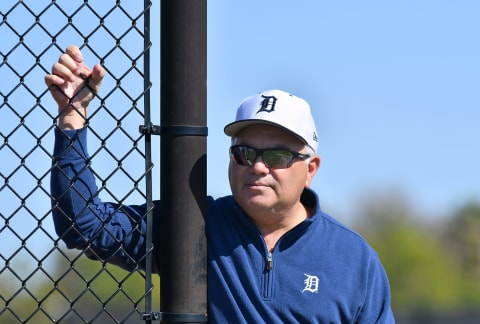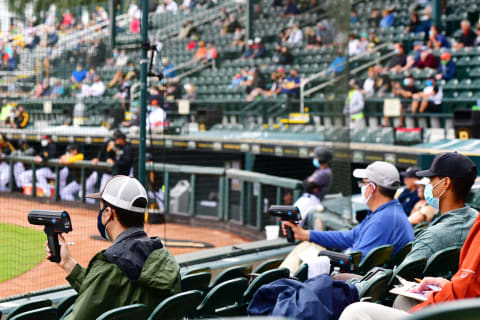How the Detroit Tigers can take their front office approach to free agency

The Detroit Tigers front office strategy would translate well in free agency this winter
There has been overwhelming relief among the Detroit Tigers fanbase since the club brought in Scott Harris as well as the hires immediately following the change in leadership. The Detroit Tigers had a way of thinking and process that, while evolving in some areas, remained the same at its core for nearly two decades.
Dave Dombrowski was hired in 2002 and brought along Al Avila as his assistant GM during his tenure. When Dombrowski and the Tigers parted ways in 2015, the club promoted Avila internally and effectively kept a large part of the front office intact. It is noteworthy the club built an analytics department from scratch and vastly expanded its player development structure under Avila. Still, these changes served more like an awkward and obvious addition to an existing home.
While Scott Harris wasn’t willing to call this a complete teardown, there have been sweeping changes that have come with the structural realignment in departments spanning from training and performance to scouting and strength. The club will not be renewing Kevin Rand’s contract, who was serving in Lakeland; Doug Teter, former head athletic trainer with the MLB club, will assume a similar role to Rand in Lakeland; former Assistant GM David Chadd and the Tigers agreed mutually to part ways; former assistant hitting coach Mike Hessman accepted a job within player development; strength coach Steve Chase will not return; and on, and on.
Sounds as though Tom Moore, the Tigers' director of international ops, will remain with the organization.
— Cody Stavenhagen (@CodyStavenhagen) October 25, 2022
Harris also said he feels good about the org's pro scouting under Scott Bream and Sam Menzin.
Harris is correct in a way–the club still has Director of Player Development Ryan Garko and Assistant GMs Jay Sartori and Sam Menzin with the organization, along with several other pro scouting and development hires–but with the changes at the top, look for the Tigers brass to be more influential on many of their retained front office talent, rather than those underneath trying to influence the top.
Could this cohesion translate into the club’s approach with their major league personnel this offseason? It certainly should.

The Detroit Tigers should hire over instead of promote under
As stated earlier, Avila was an internal promotion following the dismissal of Dave Dombrowski. Granted, at the time, Avila was considered one of the more up-and-coming executives in the game and many in the league felt he’d be in line for a shot at General Manager some day regardless–but Avila was charged with what was then called a ‘re-tooling’ of the roster, but was eventually labeled a rebuild after an unsuccessful 2016 season.
The Detroit Tigers took the same approach with their MLB club for years. Players that came up through the minor leagues were promoted internally with no real competition from the outside. Those who performed were given more prominent roles (take Gregory Soto, for example), and those who did not were replaced with a different internal option (take JaCoby Jones for Akil Baddoo).
Rather than the Detroit Tigers gifting the job to someone like Sam Menzin, they did an exhaustive search and felt as if they hired the best candidate possible, regardless of their current role with the organization. The Detroit Tigers desperately need this philosophy implemented into their acquisition strategy for MLB talent.
Note that Menzin is still in the organization–this isn’t calling for a huge turnover necessarily (although that will undoubtedly be part of the equation), but rather, bringing in better talent so that existing players don’t need to play the most prominent role. Examples where this can be deployed include the closer role with Gregory Soto and Jonathan Schoop at second base.
Most fans like Soto and the results have been solid, but we can agree he’s no Josh Hader or Aroldis Chapman–but that’s okay. Soto can still help and be a vital piece of the bullpen without needing to come in on every save situation. Likewise, Schoop’s defense is valuable and his versatility within the infield can provide value, but his offense wasn’t playoff-caliber this season. To limit his at-bats, the club can still use him as a defensive replacement or put him in more favorable match-ups without casting him away and creating $7.5 million in dead money.

The Detroit Tigers need a rare combination of youth and experience
Scott Harris’ approach of acquiring, retaining, and developing young talent was widely applauded by fans and news outlets alike–and although the Tigers have been retaining their prospects for years, the idea of utilizing every avenue to bring in that young talent is invigorating for a fanbase that has largely relied on MLB drafts as their main source of excitement in past years.
SPENCER TORKELSON FOR THE LEAD. SHEEEEEESH. pic.twitter.com/NV3YBSTHUN
— Detroit Tigers (@tigers) April 16, 2022
The game has shifted considerably in the last decade in a way that’s more conducive to young players. Justin Verlander and Max Scherzer have become unicorns in a game that has largely pushed out veterans after age 35. There could be many reasons why this is, but largely it’s simply a shift in the way the game is played.
Defensive metrics have infiltrated the game and can now be measured; giving credence to speed beyond the basepaths. The pitchers are throwing harder. From the hitter’s perspective, it requires quick twitch and elite reaction times. For pitchers, it favors a younger arm with less mileage. Additionally, home runs have become a large part of offensive production, leaving older finesse players to either bulk up or back out.
In Scott Harris, the Detroit Tigers have attained a rare combination of experience, expertise, and youth. Harris pushed back at the notion of being an analytics-based thinker, but he has undoubtedly been infiltrated in the information era in baseball during his time with the Chicago Cubs and San Fransisco Giants.
The Tigers, likewise, did the same when they hired Rob Metzler, a 42-year-old who had 15 years of experience with the Tampa Bay Rays.
Acquiring young players is often talked about in the context of prospects, but if the Detroit Tigers can find a way to acquire young players who can be instantly inserted into a prominent role, it will do worlds for speeding up the club’s competitive window moving forward.

The Detroit Tigers shouldn’t shy from turnover
Playing baseball on the world’s biggest stage is competitive and cutthroat in many ways. When one’s team finishes near the bottom of the standings after an expected and measurable improvement, changes should go beyond crossing fingers and making mechanical adjustments.
If the rebuild is indeed over and the Detroit Tigers are going to do what they can to build a competitive product in short order, this roster simply will not do. Bench options are galore and the team will need decisions on several in the infield and outfield as they begin to fill needs.
Luckily, deciding a player isn’t in the plans for the roster to begin the season doesn’t have to mean cutting ties altogether. For many, they may have minor league options available (think Ryan Kreidler or Kerry Carpenter) that would allow them to be depth pieces in the event of injury or absence. These players have value, but starting each in Toledo would be prudent if the goal is competitiveness.
However, just as the Tigers parted ways with many longtime staffers, the team should not be afraid to ‘lose’ players if it is in the best interest of the organization and its relevance to their major league club.
Next. Detroit Tigers 40-man roster breakdown: 60-day IL. dark